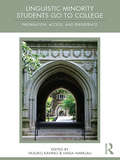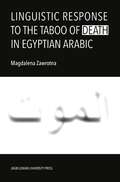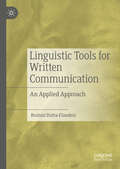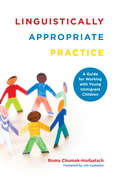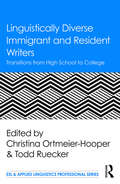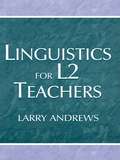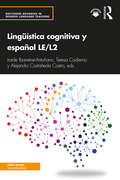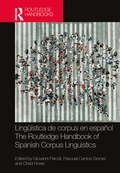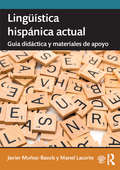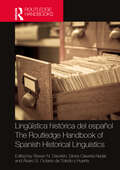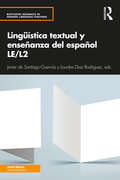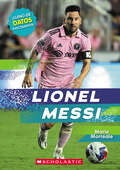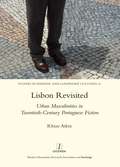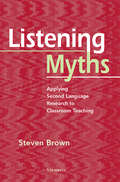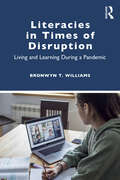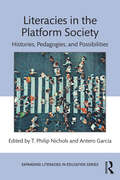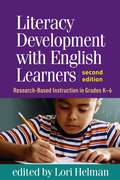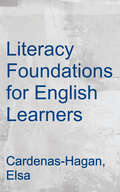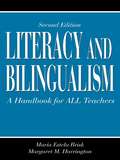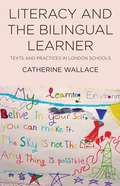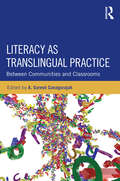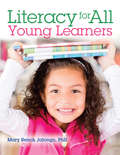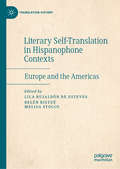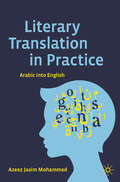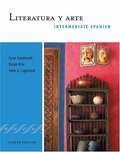- Table View
- List View
Linguistic Minority Students Go to College: Preparation, Access, and Persistence
by Yasuko Kanno Linda HarklauCurrently, linguistic minority students – students who speak a language other than English at home – represent 21% of the entire K-12 student population and 11% of the college student population. Bringing together emerging scholarship on the growing number of college-bound linguistic minority students in the K-12 pipeline, this ground-breaking volume showcases new research on these students’ preparation for, access to, and persistence in college. Other than studies of their linguistic challenges and writing and academic literacy skills in college, little is known about the broader issues of linguistic minority students’ access to and success in college. Examining a variety of factors and circumstances that influence the process and outcome, the scope of this book goes beyond students’ language proficiency and its impact on college education, to look at issues such as student race/ethnicity, gender, SES, and parental education and expectations. It also addresses structural factors in schooling including tracking, segregation of English learners from English-fluent peers, availability and support of institutional personnel, and collegiate student identity and campus climate. Presenting state-of-the-art knowledge and mapping out a future research agenda in an extremely important and yet understudied area of inquiry, this book advances knowledge in ways that will have a real impact on policy regarding linguistic minority immigrant students’ higher education opportunities.
Linguistic Response to the Taboo of Death in Egyptian Arabic
by Magdalena ZawrotnaThe work presents a study of the linguistic and pragmatic response to the taboo of death in Egypt. The analysis leads the author to the conclusion that the experience of death in Egyptian society is mediated by religion. The reaction to death announcements includes a number of strategies to protect both the author of the utterance and its recipient against the effects of the taboo related to this topic. The most important feature of the studied communication is formulaicity, which is at the same time the central idea and the methodological frame of the work presented here.The discourse analyzed here fits within the Arab-Muslim rhetorical framework. In the daily utterances of the Egyptians, divine agency is believed to be constantly present, which is attested in numerous ritual practices. As part of the quantitative study and the structural analysis of the material, a pattern was distinguished in which individual types of formulas occur in their fixed places and a specific order. Qualitatively, many of the statements in the material are strongly emotional. To enhance the pragmatic effect, phrases are combined with each other, repetitions, prayers, poetic attempts and quotes from the Quran/ Hadith appear. Most of the phrases used in response to the taboo of death are prefabricated items recalled from memory almost automatically. Further analysis proposes to look at the formulae in the context of taboo and strong emotions related to it. Using formulaic sequence instead of generating novel language enables. the author of the utterance to convey emotional support to the suffering person and, at the same time, eliminates ambiguity. The methodology proposed here offers a new insight into the language of everyday communication, through the lens of its pragmatic usefulness and linguistic etiquette, taking into account the cultural framework in which the analyzed utterances are performed.
Linguistic Tools for Written Communication: An Applied Approach
by Reshmi Dutta-FlandersThis book uses a linguistically and stylistically grounded analytical approach to written discourse to explain the patterns that appear when evaluating academic essays, and to explore the potential of ‘nativized’ linguistic tendencies as strategies in written communication. As 'linguistic behaviour', these strategies constitute a multinorm, and the author argues that comprehensive awareness of a written norm in a multilingual context is not about language rules for ironing out inequalities, but rather about varieties of linguistic practices that construct alternative strategies and patterns in written discourse. The book combines topics such as study skills, English as a Second Language and English for Academic Purposes, but grounds them within a World Englishes and syntactic paradigm, exploring why students write in a certain way due to their linguistic instincts, as well as helping students to see practical examples of what this means from the immediate perspective of sentence construction. It will be of interest to scholars of Education, Language and Linguistics, Study Skills, EAP and World Englishes, as well as students across disciplines who are encountering the academic essay as a form for the first time.
Linguistically Appropriate Practice: A Guide For Working With Young Immigrant Children
by Roma Chumak-HorbatschThis path-breaking book provides a convincing argument for the importance of children's home languages and the benefits of dual- and multi-language learning. A new classroom practice known as Linguistically Appropriate Practice (LAP) offers guidance for those working with young children who arrive in childcare centres and schools with little or no proficiency in the classroom language. Linguistically Appropriate Practice details over fifty classroom activities that can be adapted to match both the developmental level of the children and the classroom curriculum. Intended for childcare staff, health care providers, settlement workers, speech and language pathologists, kindergarten and primary grade teachers, family resource workers, and literacy specialists, this book is an essential resource for preparing young children for the complex communication and literacy demands of the twenty-first century.
Linguistically Diverse Immigrant and Resident Writers: Transitions from High School to College (ESL & Applied Linguistics Professional Series)
by Todd Ruecker Christina Ortmeier-HooperSpotlighting the challenges and realities faced by linguistically diverse immigrant and resident students in U.S. secondary schools and in their transitions from high school to community colleges and universities, this book looks at programs, interventions, and other factors that help or hinder them as they make this move. Chapters from teachers and scholars working in a variety of contexts build rich understandings of how high school literacy contexts, policies such as the proposed DREAM Act and the Common Core State Standards, bridge programs like Upward Bound, and curricula redesign in first-year college composition courses designed to recognize increasing linguistic diversity of student populations, affect the success of this growing population of students as they move from high school into higher education.
Linguistics for L2 Teachers
by Larry AndrewsLinguistics for L2 Teachers is designed to help bilingual and ESL teachers better understand how and why the English language works, and to broaden their abilities to help their students learn about the various functions of English in the real world. It is not a complete curriculum in English linguistics, but rather, a foundation from which teachers can continue to grow and to teach with greater confidence. The reader-friendly, conversational style makes the concepts easily accessible to preservice and in-service teachers who have little or no previous experience in language study. This textbook: * explains various aspects of English using non-technical terminology; * goes beyond the study of grammar to examine the functions of language, not just its form; * presents language applications in L2 classrooms; and * clearly delineates the significance of chapter topics for L2 teachers and students. Each chapter includes prereading activities to enhance the reader's comprehension; postreading activities to expand and elaborate the concepts; and interactive "Be A Linguist" activities to help readers think in ways similar to the ways linguists think and to provide opportunities to apply ideas explained within the chapter. Intended for all teachers of students for whom English is a new language, this text will help them be better prepared to meet the important challenges and questions they encounter in their classrooms.
Lingüística cognitiva y español LE/L2 (Routledge Advances in Spanish Language Teaching)
by Iraide Ibarretxe-Antuñano Teresa Cadierno Alejandro Castañeda CastroLingüística cognitiva y español LE/L2 constituye una valiosa aportación al estudio de la adquisición y la enseñanza del español LE/L2 desde la perspectiva teórica de la lingüística cognitiva. Se trata de la primera obra escrita en español en la que se ofrece una introducción a la lingüística cognitiva y su aplicación didáctica a la enseñanza del español LE/L2 desde una óptica internacional. Combina una orientación teórico-práctica que incluye diferentes estudios empíricos con pautas para ayudar a los profesores de español a integrar la lingüística cognitiva en la enseñanza de la lengua. Características principales: Una estructura homogénea y facilitadora de la lectura de los distintos capítulos que sirve para integrar contenidos lingüísticos y gramaticales desde un punto de vista cognitivo; Cuestiones clave en la enseñanza del español LE/L2 desde la óptica de la lingüística cognitiva: aspectos controvertidos de gramática, el desarrollo de la competencia metafórica, el aprendizaje del léxico, la influencia de la lengua materna, el foco en la forma, el uso de la traducción pedagógica; Pautas y sugerencias para aplicar la lingüística cognitiva en la enseñanza de la lengua, así como futuras vías de investigación; Una selección de imágenes, gráficos e ilustraciones para facilitar la comprensión de los temas y conceptos que se abordan en el volumen; Un glosario bilingüe (español e inglés) de términos clave para que cualquier lector pueda familiarizarse con los conceptos fundamentales de la lingüística cognitiva. Escrito en español, de manera clara y accesible, y con abundantes ejemplos, Lingüística cognitiva y español LE/L2 es una obra de referencia para docentes de español como LE/L2, estudiantes graduados y formadores de profesores, así como para cualquier persona que desee adquirir una perspectiva actual sobre las principales aportaciones teóricas y prácticas de la lingüística cognitiva a la enseñanza y el aprendizaje de segundas lenguas.
Lingüística de corpus en español / The Routledge Handbook of Spanish Corpus Linguistics (Routledge Spanish Language Handbooks)
by Javier Muñoz-Basols Manel Lacorte Chad Howe Pascual Cantos-Gómez Giovanni ParodiLingüística de corpus en español/The Routledge Handbook of Spanish Corpus Linguistics muestra el modo en que ha cambiado el panorama de la denominada lingüística de corpus en español y cómo en la actualidad ha llegado a concitar un espacio disciplinar independiente, y, al mismo tiempo, integrar estos conocimientos en cualquier programa de estudios, investigación o diseño curricular en educación superior. Este volumen lo componen 36 capítulos que ofrecen un panorama amplio, diverso y comprehensivo de los avances en lingüística de corpus de y en español, abarcando un vasto repertorio de conceptos esenciales y de aspectos teóricos y metodológicos desde una conceptualización de la lingüística contemporánea tanto inter como transdisciplinaria. Los ámbitos que se cubren no son ni estancos, ni definitivos, ni, mucho menos, los únicos. Son perfectamente susceptibles de revisión, de mejora y/o de cambio. El objetivo último de esta obra no es el limitar o fijar, sino todo lo contrario, es el de motivar y provocar a los lectores y lectoras para que no cesen las avenidas de propuestas innovadoras en el ámbito de la lingüística de corpus del español y seguir así profundizando en el conocimiento de esta lengua. Lingüística de corpus en español / The Routledge Handbook of Spanish Corpus Linguistics shows how the landscape of corpus linguistics in Spanish has changed and how it has become an independent discipline while incorporating this knowledge into any syllabus, research or curriculum design in higher education. This volume comprises 36 chapters that provide a broad, diverse and comprehensive overview of advances in corpus linguistics of and in Spanish, covering a vast repertoire of essential concepts as well as theoretical and methodological aspects from a conceptualization of contemporary linguistics that is both inter- and transdisciplinary. The fields covered are not definitive, or even the only ones. They are entirely open to revision, improvement and/or change. The goal of this work is not to fix or limit these topics. On the contrary, it is intended to motivate and provoke the readers to continue exploring new avenues of innovative proposals in the field of Spanish corpus linguistics and thus deepen their knowledge of this language.
Lingüística hispánica actual: guía didáctica y materiales de apoyo
by Manel Lacorte Javier Munoz-BasolsLingüística hispánica actual provides step-by-step instructions on how to plan, design, and teach introductory Hispanic Linguistics courses. It is a versatile resource, which can be used in conjunction with Introducción a la lingüística hispánica actual: teoría y práctica. It contains an answer key for all the activities in the main textbook. It also includes additional activities, with clear and accessible explanations for students and instructors, and can accompany other existing texts and courses on Hispanic Linguistics. Features include: • A comprehensive selection of materials which gradually introduce students to the main areas of Hispanic Linguistics: General Linguistics, Phonology and Phonetics, Morphology, Syntax, Semantics and Pragmatics, History of the Spanish Language, Language Variation, and Second Language Acquisition and Language Teaching. • A wide range of carefully-crafted classroom and homework activities, essay questions and research projects to engage students and enrich their learning of Hispanic Linguistics. • Detailed guidance on how to successfully implement each activity in the classroom, suggestions for how to expand and adapt activities for different needs, and a full annotated answer key for instructors to save time planning and implementing lessons. • An extensive bilingual glossary of terms for each of the disciplines covered in the guide helps teachers introduce key concepts and terms in the classroom. Lingüística hispánica actual provides a wealth of activities specially designed to make learning Hispanic Linguistics more dynamic and enjoyable for students.
Lingüística histórica del español / The Routledge Handbook of Spanish Historical Linguistics (Routledge Spanish Language Handbooks)
by Steven N. Dworkin Gloria Clavería Nadal Álvaro S. Octavio de Toledo y HuertaLingüística histórica del español/The Routledge Handbook of Spanish Historical Linguistics ofrece una síntesis actualizada de los diversos campos que componen la lingüística histórica del español. Este volumen, pionero en su género, estudia la historia interna y externa de la lengua española con atención a los desarrollos teóricos y conocimientos contemporáneos sobre la naturaleza del cambio lingüístico y sobre el papel de los factores no lingüísticos en tales procesos. El volumen, escrito íntegramente en español, reúne contribuciones de un nutrido grupo de expertos internacionales. Con capítulos tanto de destacados filólogos como de lingüistas de orientación más teórica, el volumen ofrece a los lectores una panorámica equilibrada y completa del objeto de estudio desde muy diversas perspectivas de investigación. Esta obra aspira a servir de referencia en el campo de la lingüística histórica española y resultará de interés para estudiosos y profesores interesados en dicho ámbito, así como para los estudiantes de lingüística hispánica. Lingüística histórica del español / The Routledge Handbook of Spanish Historical Linguistics provides a state-of-the-art synthesis of the various fields that comprise Spanish historical linguistics. The first of its kind, the volume studies the internal and external history of the Spanish language within the framework of contemporary developments and insights into the nature of language change and into the role of non-linguistic factors in these processes. Written in Spanish, the volume brings together an international group of expert contributors. With chapters from both eminent philologists as well as more theoretically- oriented linguists, the volume provides readers with a well-balanced and comprehensive overview of the field from many different research perspectives. The volume will be an essential reference on Spanish historical linguistics and will be of interest to scholars and teachers in the field of Spanish historical linguistics, as well as students in Spanish linguistics.
Lingüística textual y enseñanza del español LE/L2 (Routledge Advances in Spanish Language Teaching)
by Javier de Santiago-Guervós; Lourdes Díaz Rodríguez; Javier Muñoz-BasolsLingüística textual y enseñanza del español LE/L2 ofrece una visión de conjunto teórico-práctica y actualizada de la Lingüística textual aplicada a la enseñanza del español como lengua extranjera y/o segunda, destinada especialmente a estudiantes graduados y a profesores en formación nativos y no nativos. El volumen, escrito por un elenco internacional de profesores-investigadores, presenta una visión actualizada y práctica de los géneros textuales más frecuentes en programaciones universitarias. Enmarcado por una síntesis actualizada de estudios e investigaciones en lingüística aplicada que recorre distintas perspectivas teóricas y metodológicas, recoge datos y propuestas procedentes de aulas de aprendizaje de español de distintos contextos internacionales. Su principal propósito es suscitar la reflexión teórico-práctica sobre los géneros discursivos y su papel en el aula, y ofrecer una descripción pormenorizada de los mismos para proporcionar al profesorado en formación, nativo y no nativo, recursos prácticos y propuestas didácticas que ejemplifican y guían de manera razonada cómo llevar al aula los distintos géneros textuales. Características principales: • Amplitud de aspectos de la lingüística textual y géneros discursivos abordados enteramente para el español LE/L2 y en español. • Estructuración homogénea de los capítulos que facilita la lectura y da coherencia al conjunto. Atención a géneros escritos y orales desde una perspectiva teórico-práctica que puede inspirar nuevas investigaciones. Atención a la diversidad geolectal del español, a los contextos en que este es L2 (Europa, EEUU) y a la de sus aprendices (hablantes de herencia, L2, LE). Orientado a la aplicación práctica y docente en la clase de L2/LE, cada capítulo dedicado a un género incluye consejos, pautas o actividades para el aula. Incluye temática actual en lingüística textual y aprendizaje de lenguas: escritura académica, divulgación científica, textos jurídicos, aprendizaje mediado por ordenador o el lenguaje de las redes. Capítulos bien fundamentados teórica y bibliográficamente, con sólido respaldo de datos empíricos procedentes de corpus, bien contextualizados. Aborda los aspectos teóricos tradicionales relativos al estudio de la tipología textual y los desafíos metodológicos que afronta el profesor al llevar al aula los distintos géneros discursivos. La presente obra presenta, en un solo volumen, una visión actualizada y práctica de los tipos textuales y géneros discursivos de uso más frecuente desde una perspectiva teórico-práctica: presentación, descripción y puesta en práctica es un esquema de trabajo directo y enormemente útil para su aplicación en el aula. El ámbito internacional en el que se mueven los autores le da una amplitud nunca antes recogida en una obra de lingüística textual. Todo ello hace de Lingüística textual y enseñanza del español LE/L2 una obra de consulta obligada para docentes de español como LE/L2, para estudiantes graduados y formadores de profesores, así como para cualquier persona que desee adquirir una perspectiva actual sobre lingüística textual, géneros discursivos y enseñanza e investigación en español nativo y no nativo.
Lionel Messi (Real Bios)
by Marie MorrealeDiscover how Lionel Messi became an international superstar in this updated edition!¡Descubre cómo Lionel Messi se convirtió en una superestrella internacional del fútbol en esta edición actualizada!Revised and updated! As the biggest star in the world's most popular sport, Lionel "Leo" Messi is an international celebrity. But in many ways, he's just a regular guy.Readers will learn about Leo's favorite foods and pastimes and find out how he likes to spend time with his family. They will also learn how he got his start as a soccer player and how he became an international superstar. With up-to-date information, including his move to America to play for Inter Miami in July 2023, this revised edition is a must-have for all Messi fans!¡Revisado y actualizado! El mejor jugador del deporte más popular del mundo, Lionel "Leo" Messi es una celebridad internacional. Pero en muchos sentidos, es sólo un tipo normal.Con este libro, los lectores descubrirán cuáles son las comidas y pasatiempos favoritos de Leo y cómo le gusta estar con su familia. También aprenderán sobre sus inicios como jugador de fútbol y cómo se convirtió en una superestrella internacional. Con información actualizada, incluyendo su traslado a los Estados Unidos para jugar con el Inter Miami en julio de 2023, ¡esta edición revisada es imprescindible para todos los fans de Messi!
Lisbon Revisited: Urban Masculinities in Twentieth-Century Portuguese Fiction
by Rhian AtkinTwentieth-century Portugal saw dramatic political and social change. The monarchy was abolished, and a republic installed (1910), soon giving way to a long-lasting dictatorship (1926); a transition to democracy (1974) led to membership of the European Union (1986). But what do we know of how people lived during these periods? And how did men, in particular, respond to the changes taking place in society? In this illuminating and broad-ranging study, Rhian Atkin uses as case studies the work of Fernando Pessoa (1888-1935), Luis de Sttau Monteiro (1926-93) and Jose Saramago (1922-2010) in order to examine the relationship between socio-political change and the construction and performance of masculinities in the urban environment of Lisbon over the course of the last century.
Listening Myths: Applying Second Language Research to Classroom Teaching
by Steven BrownThis volume was conceived as a "best practices" resource for teachers of ESL listening courses in the way that Vocabulary Myths by Keith S. Folse (and Writing Myths by Joy Reid) is one for reading and vocabulary teachers. It was written to help ensure that teachers of listening are not perpetuating the myths of teaching listening. Both the research and pedagogy in this book are based on the newest research in the field of second language acquisition. Steven Brown is the author of the Active Listening textbook series and is a teacher trainer. The myths debunked in this book are: § Listening is the same as reading. § Listening is passive. § Listening equals comprehension. § Because L1 language ability is effortlessly acquired, L2 listening ability is too. § Listening means listening to conversations. § Listening is an individual, inside-the-head process. § Students should only listen to authentic materials. § Listening can’t be taught.
Literacies in Times of Disruption: Living and Learning During a Pandemic
by Bronwyn T. WilliamsThe wide-ranging disruptions of the COVID-19 pandemic altered the experiences of place, technology, time, and school for students. This book explores how students’ responses to these extraordinary times shaped their identities as learners and writers, as well as their perceptions of education.This book traces the voices of a diverse group of university students, from first-year to doctoral students, over the first two years of the pandemic. Students discussed the effects of having their homes forced to serve as classrooms, work, and living spaces, as they also navigated much of school and life through their digital screens. The affective and embodied experiences of this disruption and uncertainty, and the memories and narratives constructed from those experiences, challenged and remade students’ relationships with place, digital media, and school itself. Understanding students’ perceptions of these times has implications for imagining innovative and empathetic approaches to literacy and learning going forward.In a time when disruptions, including but not limited to the pandemic, continue to ripple and resonate through education and culture, this book provides important insights for researchers and teachers in literacy and writing studies, education, media studies, and any seeking a better understanding of students and learning in this precarious age. 2025 recipient of the Divergent Publication Award for Excellence in Literacy in a Digital Age Research from the Initiative for Literacy in a Digital Age
Literacies in the Platform Society: Histories, Pedagogies, and Possibilities (Expanding Literacies in Education)
by Antero Garcia T. Philip NicholsAs digital platforms become increasingly common and even the norm for literacy learning environments, established frameworks, pedagogies, and theories do not always translate neatly to these new contexts. This edited volume explores the complex relationship between digital platforms and literacies, understanding that they have become an unavoidable part of the literacy and education ecosystem. The chapters address a range of contexts and considerations around the social, technical, and economic complexities of platform technologies and how they have remade literacy teaching and learning. Insightful and innovative, this is key reading for literacy scholars, researchers, and graduate students.
Literacy Development with English Learners, Second Edition: Research-Based Instruction in Grades K-6
by Lori HelmanAs the number of students learning English in elementary schools across the country continues to grow, so does the body of research on their literacy development. This respected course text and teacher resource synthesizes cutting-edge scholarship on how to teach English learners (ELs) at all levels of English proficiency. Accessible chapters on key components of reading and writing combine theoretical issues with practical suggestions for the classroom. Case studies, vignettes, and samples of student work illustrate both the challenges facing emergent bilingual students and the types of high-quality instruction that can help them succeed. New to This Edition *Incorporates the latest research and key current topics, such as bilingual assessment. *Chapter on vocabulary instruction across the elementary grades. *Chapter on collaborative teaching and how to structure it. *Covers implementation of the Common Core State Standards with ELs.
Literacy Foundations for English Learners: A Comprehensive Guide to Evidence-Based Instruction
by Elsa Cárdenas HaganMore than 5 million English learners attend U.S. public schools—and yet fewer than 3% of teachers are certified to work with them. Fill that gap in teacher education with this practical and comprehensive textbook, an evidence-based guide to providing English learners in Pre-K–Grade 6 with explicit, systematic instruction on language and literacy fundamentals. <p><p>Aligned with IDA's Knowledge and Practice Standards, this book prepares current and future educators to teach English learners the key components of language and literacy, as first described in the National Literacy Panel report. For each component, teachers will get a dedicated chapter with research-based insights on how to teach English learners, guidance on making connections across languages when teaching that component, and ready-to-use principles and strategies for instruction. Learning objectives, study questions, and extended application activities help educators grow their knowledge and apply it in their classrooms. <p><p>An essential text for courses on literacy foundations and biliteracy—and an ideal in-service professional development resource—this accessible book will give teachers the knowledge base they need to help English learners develop strong literacy skills and achieve academic success.
Literacy and Bilingualism: A Handbook for ALL Teachers (2nd Edition)
by Maria Estela Brisk Margaret M. HarringtonThis handbook applies proven techniques, derived from bilingual/bicultural classrooms, to teaching literacy in the twenty-first century. Its goal is to help teachers increase their understanding of bilingual learners in order to maximize instruction. Teachers can use this handbook to expand their understanding of literacy and bilingualism; implement literacy approaches and assess students’ development; and learn through reflection. Practical, flexible format and content. Complete and straightforward instructions, illustrated by case studies, allow teachers to use the strategies in this handbook on their own or in teacher-led study groups. They can select from the variety of approaches the ones which best match their students’ needs and their own teaching style. Student-centered focus. All of the approaches share characteristics that help motivate students of varying language abilities to develop literacy. Field-tested approaches. The approaches have been modified and tested with bilingual students of different ages and language backgrounds in bilingual, ESL, mainstream, special education, and deaf education classes ranging from preschool through high school. New in the Second Edition: *five new approaches with their corresponding classroom implementation;*additional information in each introduction addressing its theme;*new material on issues of language, culture, and literacy development of students completely new to the English language; and*annotated bibliographies with sample books to support literacy within language and content area classes. Literacy and Bilingualism is intended for a broad audience of teachers in any type of classroom where bilingualism plays a role, and is an excellent text for preservice and inservice courses that prepare teachers to work with English language learners.
Literacy and the Bilingual Learner: Texts and Practices in London Schools
by Catherine WallaceLiteracy and the Bilingual Learner explores the literacy development of bilingual learners in London (UK) schools and colleges through a series of vignettes and case studies of learners and their educational experiences.
Literacy as Translingual Practice: Between Communities and Classrooms
by A. Suresh CanagarajahThe term translingual highlights the reality that people always shuttle across languages, communicate in hybrid languages and, thus, enjoy multilingual competence. In the context of migration, transnational economic and cultural relations, digital communication, and globalism, increasing contact is taking place between languages and communities. In these contact zones new genres of writing and new textual conventions are emerging that go beyond traditional dichotomies that treat languages as separated from each other, and texts and writers as determined by one language or the other. Pushing forward a translingual orientation to writing—one that is in tune with the new literacies and communicative practices flowing into writing classrooms and demanding new pedagogies and policies— this volume is structured around five concerns: refining the theoretical premises, learning from community practices, debating the role of code meshed products, identifying new research directions, and developing sound pedagogical applications. These themes are explored by leading scholars from L1 and L2 composition, rhetoric and applied linguistics, education theory and classroom practice, and diverse ethnic rhetorics. Timely and much needed, Literacy as Translingual Practice is essential reading for students, researchers, and practitioners across these fields.
Literacy for All Young Learners
by Mary JalongoEarly childhood classrooms are becoming more and more diverse. Dual languages and a wide range of reading abilities require that teachers have the resources to reach all learners in their classrooms. In Literacy for All Young Learners, Mary Jalongo, PhD, offers 65 strategies to support literacy learning with children from preschool through the third grade. With specific suggestions for ELL students, Jalongo includes recommendations for hundreds of great children's books, websites, and apps to make teaching easier. Each strategy is designed to be simple to use with all of the children in your classroom--from the not-yet-readers to the fluent readers--and each strategy is tied to the Common Core State Standards for kindergarten through third grade. Downloadable digital content includes sample parent letters in English and Spanish, extra book-based activities, and technology supports.
Literary Self-Translation in Hispanophone Contexts - La autotraducción literaria en contextos de habla hispana: Europe and the Americas - Europa y América (Translation History)
by Lila Bujaldón de Esteves Belén Bistué Melisa StoccoThis edited book contributes to the growing field of self-translation studies by exploring the diversity of roles the practice has in Spanish-speaking contexts of production on both sides of the Atlantic. Part I surveys the presence of self-translation in contemporary Indigenous literatures in Spanish America, with a focus on Mexico and the Mapuche poetry of Chile and Argentina. Part II proposes to incorporate self-translation into the history of Spanish-American literatures- including its relation with colonial multilingual-translation practices, the transfers it allowed between the French and Spanish-American avant-gardes, and the insertion it offered for exiled Republicans in Mexico. Part III develops new reflections on the Iberian realm: on the choice between self and allograph translation Basque writers must face, a new category in Xosé Dasilva’s typology, based on the Galician context, and the need to expand the analysis of directionality in Catalan self-translations. This book brings together contributions from some of the leading international experts in translation and self-translation, and it will be of interest to scholars and students in the fields of Translation Studies, Cultural Studies, Comparative Literature, Spanish Literature, Spanish American and Latin American Literature, and Amerindian Literatures.
Literary Translation in Practice: Arabic into English
by Azeez Jasim MohammedThis book introduces the theory and practice of literary translation through the lens of original short stories translated from Arabic into English. Readers are provided with both the source text and the target language translation, alongside critical commentaries and discussion of related key concepts and issues, to allow them to see the mechanics of decision-making in this type of specialised translation. At the end of each section, exercises, discussion questions and practice texts encourage students to apply what they've learned. This textbook will be an ideal resource for students on advanced undergraduate and postgraduate courses on Specialised - especially Literary - Translation, Translation Theory, Issues in Translation and Middle Eastern Culture and Literature.
Literatura y Arte Intermediate Spanish (8th Edition)
by Ralph Kite Lynn A. Sandstedt John G. CopelandIntermediate Spanish Literature and Art textbook with brief English translations.
